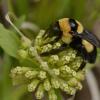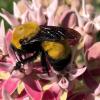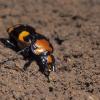
(Coleoptera: Cicindelidae)
Cicindela hirticollis siuslawensis is 10-15 mm long with tufts of long white hairs on the side of the thorax and a front marking shaped roughly in the form of a G. This front marking has a very small or absent tail. The beetle’s elytra (outer wings) are brownish green to green with thin maculations (Pearson, et al. 2006), although Mike Kippenhan (personal communication) has never observed a green C. h. siuslawensis and believes they tend to be browner to brownish green. The markings on C. h. siuslawensis are distinct; it is unlikely to be confused with any other tiger beetle species that lives within its range.
There is another sub-species of C. hirticollis in Oregon. C. h. couleensis is known along sandy beaches of the Columbia and Snake rivers in eastern Washington and Oregon extending west to Cowlitz County Washington where individuals exhibit some intergrade characters with C. h. siuslawensis. However, there are no populations of C. h. couleensis within 100 km of the nearest C. h. siuslawensis populations (Pearson, et al. 2006).
See Graves, et al. 2005 and Pearson, et al. 2006 for a key to the species and sub-species in this genus.
Larval burrows are typically shallow (8-20cm) and with a high density along sandy soils near surface water or where the subsurface soil is constantly moist. Larvae are known to crawl across the soil surface to relocate their burrow in response to changing soil moisture levels (Pearson, et al. 2006).
C. hirticollis will overwinter as either an adult or a larva. Adults are active from April to October with two peaks: one from April to late June and the other from early August to September (Pearson, et al. 2006). Tiger beetles are predators as both larvae and adults. Both eat a variety of insects and other invertebrates. Larvae reach out from burrows to ambush passing prey. Adult are fast runners they chase down and subdue prey. Adults will also fly (Pearson, et al. 2006).
Historic
C. h. siuslawensis is known from Pacific Ocean beaches at the mouths of rivers from the central Washington coast south to Eureka, California (Pearson, et al. 2006). Specimens have been collected from a variety of sites in Oregon including: Twin Rocks (7/10/40) and Sand Lake (8/24/41) in Tillamook County; Waldport (06/22/30, 8/10/41, and 7/5/42) in Lincoln County; and Siltcoos Outlet in Lane County (5/18/57) (OSU Collection). In Washington a specimen was collected from Ocean Park (7/4/35) in Pacific County (OSU Collection). A few individuals have been collected from California, but not in recent years (Knisley personal communication).
Current
C. h. siuslawensis has been extirpated from most of its historic sites and is considered rare (Pearson, et al. 2006). Recent sightings have been made in Oregon at Johnson Creek near the Golf Course in Bandon in Coos County (Kippenhan personal communication) and at the New River Area of Critical Environmental Concern at the Storm Ranch section just north of the New River boat launch, approximately 8 miles south of Bandon in Coos County (Lyons personal communication).
Mike Kippenhan noted that he had looked at all the sites north of Florence and could not find any individuals of this sub-species. He believes those areas are too disturbed by human activity, especially Off Road Vehicle (ORV) use, to support C. h. siuslawensis. He has also looked at Cape Blanco and the Pistol River and did not find any individuals (Kippenhan personal communication).
In Washington, Mike Kippenhan collected a specimen near Pacific Beach in Grays Harbor County but believes that the sub-species has been extirpated from most Washington sites (Kippenhan personal communication).
Heritage Global Rank: G5T1T2
Heritage State Rank: Oregon (S1S2), Washington (S1S2)
Physical disturbance of its sandy beach habitat, particularly by human activity such as ORV use is a major threat (Kippenhan personal communication). In additional to physical disturbances it has a narrow range of moisture tolerance that make it susceptible to droughts, pollution, pesticides, river damming, channelization, and other shoreline modification by humans (Pearson, et al. 2006). Several other sub-species of C. hirticollis have experienced similar declines. According to Pearson, et al. (2006) the species has disappeared from many of its former habitats in New England. Many Great lakes populations have disappeared in the last 50 years. The coastal Pacific forms are rare and difficult to locate in California. The Sacramento Valley Hairy-necked Tiger Beetle, C. h. abrupta, is known from only a few sites in Northern California. In a recent survey of historic sites, no adults or larvae were found (Knisley, et al. 2005 and Pearson, et al. 2006).
Surveys are needed to verify the current range of C. h. siuslawensis along the Oregon and Washington coast. In order to conserve this species, ORV use or other human activity that will physically disturb the sandy beaches at known locations of C. h. siuslawensis should be discouraged or prohibited.
NatureServe. 2007. NatureServe Explorer: An online encyclopedia of life [web application]. Version 6.2. NatureServe, Arlington, Virginia. (Accessed: September 22, 2008).
Oregon State University Arthropod Collection. Dr. Christopher J. Marshall, Collection Manager and Assistant Curator. Corvallis, OR. Species ID # 000062250, 000062251, 000062252, 000062253, 000062254, 000062255, 000062256, 000062257, 000062258, and 000062259.
Graves, R.C., M.E. Krejci, and A.C.F. Graves. 1988. Geographic variation in the North American tiger beetle, Cicindela hirticollis Say, with a description of five new subspecies (Coleoptera, Cicindelidae). Canadian Entomologist, 120(7): 647-678.
Knisley, C. Barry and Michael S. Fenster. 2005. Apparent Extinction of the Tiger Beetle, Cicindela Hirticollis Abrupta (Coleoptera: Carabidae: Cicindelinae). The Coleopterists Bulletin, 59(4): 451-458.
Pearson, David L., C. Barry Knisley, and Charles J. Kazilek. 2006. A Field Guide to the Tiger Beetles of the United States and Canada. Oxford University Press. Oxford, New York. 227 pp.
Personal communication
Mike G. Kippenhan
C. Barry Knisley
Ronald W. Lyons
The Xerces Society for Invertebrate Conservation
We would like to thank Ron Lyons for use of his photos and observations, Mike Kippenhan for his input, Christopher Marshall for his assistance at the OSU Arthropod Collection, and C. Barry Knisley for his review and feedback.





